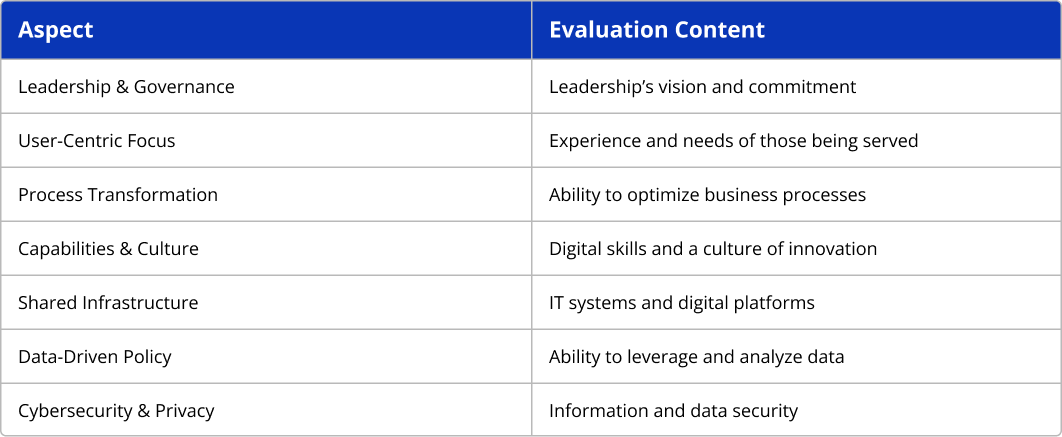Digital transformation is not merely a trend but a survival factor for businesses in the digital era. Yet, only 6.2% of businesses in Vietnam have clearly defined digital transformation goals, and just 7.6% have detailed plans. So, how can your business stay ahead?
Quick Summary:
- Leadership: Commitment from top management is crucial.
- Employees: 84% are willing to learn new skills, but only 43% feel confident adapting to technology.
- Technology Infrastructure: 58.53% are prepared to upgrade, yet cost remains a major barrier.
- Evaluation & Planning: A clear checklist is essential for identifying strengths, weaknesses, and priorities.
Support Tools:
- Evaluation models like the Digital Government Framework and tools from the Ministry of Planning and Investment help measure digital capacity.
- Select digitalization projects aligned with resources and goals.
Start by assessing your current capacity, developing a detailed plan, and leveraging support tools to lead in your digital transformation journey.
Digital Maturity Assessment for Businesses
Key Evaluation Areas
Let’s examine the critical factors to consider in the digital transformation process.
Leadership Support
Commitment from leadership is decisive for any digitalization project. Leaders must actively participate, craft a clear strategic vision, allocate resources effectively, and foster a culture of innovation. This direction not only guides but motivates the entire team.[3].
Employee Readiness
A survey of 302 employees in Vietnamese SMEs revealed that attitude, self-learning ability, and personal traits greatly influence digital adoption capacity.[4].
Here are some statistics on digital skills:

Source: [1]
Current Technology Infrastructure
Evaluating current IT infrastructure helps identify weaknesses. Stats show that 58.53% are ready to upgrade IT systems, 50.78% focus on security, 27.52% implement cloud computing, and 44.74% ensure technology compatibility with partners.
Companies like Tân Cảng, Gemadept, and Vinafco have successfully implemented ERP systems for department-wide data synchronization. However, 68.3% of businesses still struggle with new tech adoption due to high costs.
Infrastructure upgrades boost operational efficiency and establish a strong foundation for future digital initiatives.
Assessment Methods
Employee Feedbacks
Feedback from employees is vital in gauging readiness for digital transformation. Employee digital experiences directly affect transformation effectiveness.[5].
The table below shows the available approaches to gathering employees’ feedback:

Benchmarking Against Industry Standards
Vietnam has developed the Digital Technology Industry Law to support transformation. Businesses must self-assess based on key and critical criteria from the draft law.
Example: The semiconductor industry aims for $100 billion in annual revenue by 2050 with 25% localization. Benchmarking helps identify specific improvement areas.
Identifying Improvement Areas
Based on industry benchmarks, businesses should target upgrade areas by forming a dedicated task force to:
- Analyze survey results for trends
- Evaluate challenges and proposal impacts
- Use X-Y charts to prioritize initiatives
Regular assessments and digital experience monitoring help identify issues early and reinforce transformation foundations.[5].
-e7652
Evaluation Tools
Standard Assessment Models
Vietnam employs readiness models such as the Digital Government Readiness Assessment, focusing on seven key aspects [6]:

The DigComp framework surveyed 723 citizens, revealing that higher education levels, public sector employment, or residence in high-index provinces correlate with better digital skills.[7].
Measurement Tools
Developed by MPI and (GIZ) assessment tools show that Vietnam’s digital score increased by 0.7 to 1.4 points from 2022 to February 2024.[9].
-
Benefits:
- Identify strengths and weaknesses by industry standards
- Support digital skill development planning
Statistics indicate that 31% of small enterprises and 29% of medium enterprises now have a clearer understanding of their employees’ digital capabilities [8]. This highlights the necessity of applying evaluation tools systematically to identify specific development needs in the digital transformation journey.
Building a Digitalization Plan
After the readiness assessment, the next step is to create a clear, detailed plan to achieve digital transformation goals.
Goals and KPIs
Set digitalization goals aligned with the national digital economy strategy. According to statistics, Vietnam’s digital economy contributed over 12% of GDP in 2023, with a compound annual growth rate (CAGR) of 19% [2].
To achieve the goal of a digital economy contributing 20% to GDP by 2025 and 30% by 2030 [10], businesses must focus on key priority areas and select digital projects that deliver tangible value.

Project Selection
Project selection should match existing resources and deployment capabilities. Currently, cost remains a key barrier [11]. Example: FPT.eInvoice reduces paperwork, integrates systems, and processes real-time data [10].
Resource Planning
Based on the goals and selected projects, businesses need to balance and optimize resources. The cost of digital transformation in Vietnam can range from VND 200 million to several tens of billions, depending on the scale of the project.[11].
Some resources optimization methods:
-
Smart Tech Investment: Choose cost-effective, efficient, and secure solutions. Example: MISA software automates accounting for accuracy and decision support [10].
- Workforce Development: Prioritize digital skill training with specific roadmaps and regular evaluations.
- Effective Budget Management: Allocate budgets in phases, prioritize high ROI projects, consider outsourcing to reduce costs and leverage expert support.
Next Steps
Key Points Summary
To succeed in digital transformation, complete the following assessment steps:

After completing the assessment steps, businesses should consider the role of consultants in the implementation process.
Expert Consulting Support
Partnering with professional consultants provides many advantages for businesses including
- Save time and costs: Leverage expert experience to minimize risks and avoid unnecessary errors.
- Ensure the right solution: Receive guidance tailored to specific needs and goals.
- Comprehensive support: From strategic planning to final outcome evaluation, your business will have consistent expert support throughout the transformation journey.
Select consultants with industry expertise and in-depth knowledge of digital transformation technology and processes. This ensures optimal resource use and the successful achievement of business objectives.




